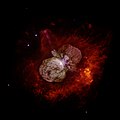Òbrôzk:Eta Carinae.jpg
Wygląd

Miara pòdzérkù – 600 × 599 pikslów. Jinszy rozdzélnotë: 240 × 240 pikslów | 480 × 480 pikslów | 769 × 768 pikslów | 1025 × 1024 pikslów | 2015 × 2013 pikslów.
Pierwòtny lopk (2015 × 2013 pikslów, miara lopka: 163 KB, ôrt MIME: image/jpeg)
Historëjô lopka
Klëkni na datum/czas, abë òbaczëc jak wëzdrzôł lopk w tim czasu.
| Datum/Czas | Miniatura | Miara | Brëkòwnik | Òpisënk | |
|---|---|---|---|---|---|
| aktualny | 10:41, 18 gòd 2017 |  | 2015 × 2013 (163 KB) | The NMI User | Reverted to version as of 14:14, 1 May 2008 (UTC) |
| 15:45, 13 str 2017 |  | 3000 × 2998 (1,18 MB) | Leogorgon | larger file size | |
| 15:14, 1 môj 2008 |  | 2015 × 2013 (163 KB) | Vol de nuit | {{Information |Description=(NASA News Release) A huge, billowing pair of gas and dust clouds are captured in this stunning NASA Hubble Space Telescope image of the supermassive star Eta Carinae. Using a combination of image processing techniques (ditheri |
Lënczi do lopka
Niżódnô starna nie lënkùje do negò lopka.
Globalné wëzwëskanié lopka
Nene lopk je téż brëkòwnóny w jinnych ùdbach Wiki:
- Wëzwëskanié w da.wikipedia.org
- Wëzwëskanié w en.wikipedia.org
- Star
- Eta Carinae
- Wikipedia:Selected anniversaries/March 11
- Wikipedia:Today's featured article/March 2017
- Wikipedia:WikiProject Wikipack Africa Content/Wikipedia:Showcase
- Wikipedia:WikiProject WikiFundi Content/Eta Carinae
- Wikipedia:Today's featured article/requests/Eta Carinae
- Wikipedia:Today's featured article/March 12, 2017
- Wikipedia:Main Page history/2017 March 12
- Wikipedia:WikiProject WikiFundi Content/Wikipedia:Showcase
- Wikipedia:Main Page history/2022 March 11
- Wikipedia:Main Page history/2022 March 11b
- Wikipedia:Main Page history/2023 March 11
- Wikipedia:Main Page history/2023 March 11b
- User:2003 LN6/sandbox/Eta Carinae variable
- List of luminous blue variable stars
- Wëzwëskanié w en.wikiversity.org
- User:Marshallsumter/Radiation astronomy2/Visuals
- User:Marshallsumter/Radiation astronomy2/Violets
- Stars/Astronomy
- User:Marshallsumter/Radiation astronomy2/Violets/Quiz
- Stars/Sun/Astronomy/Quiz
- User:Marshallsumter/Radiation astronomy/Courses/Principles/Hourly 2
- User:Marshallsumter/Radiation astronomy/Courses/Principles/Final quiz
- Draft:Original research/Io/Quiz
- Titan/Quiz
- Stars/Solar systems/Quiz
- Moon/Quiz
- Earth/Quiz
- User:Marshallsumter/Radiation astronomy/Colors/Quiz
- Volcanoes/Io/Quiz
- Stars/Violets
- User:Marshallsumter/Radiation astronomy2/Stars
- Stars/Violets/Quiz
- Wëzwëskanié w es.wikipedia.org
- Wëzwëskanié w fr.wikipedia.org
- Wëzwëskanié w hi.wikipedia.org
- Wëzwëskanié w it.wikibooks.org
- Wëzwëskanié w la.wikipedia.org
- Wëzwëskanié w mk.wikipedia.org
- Wëzwëskanié w ms.wikipedia.org
- Wëzwëskanié w my.wikipedia.org
- Wëzwëskanié w oc.wikipedia.org
- Wëzwëskanié w ru.wikipedia.org
- Wëzwëskanié w sk.wikipedia.org
- Wëzwëskanié w sr.wikipedia.org
- Wëzwëskanié w th.wikipedia.org
Pòkôżë lëstã glonal;negò brëkwaniô negò lopka.

